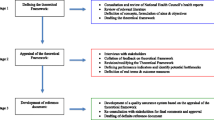Abstract
The challenge of excellence in community health services has been taken up by medical educators in Colombia. Confronted with a nation where the primary indicators of disease mortality and morbidity (cardiovascular disease and infant mortality) were characteristic of First and Third World patterns, respectively, the Ministry of Health and La Asociacion Colombiana de Facultades de Medicina (ASCOFAME), representatives of institutions of medical education, have collaborated to conduct a needs assessment of the country's health needs and devised an implementation plan designed to better address the needs of the majority of that nation's people.
As a model, the Colombian reorganization of medical education is an example which could be emulated by the U.S. where policy makers are struggling with troublesome questions of cost, equity and quality.
Similar content being viewed by others
References
Association of American Medical Colleges. The GPEP Report: Physicians for the Twenty-First Century. Washington, DC: Association of American Medical Colleges, 1984.
United Nations' International Children's Emergency Fund. The State of the World's Children. New York: Oxford University Press, 1986.
Ministerio de Salud de Colombia. Diagnostico de Salud, Politicas y Estrategias. Bogotá: Ministerio de Salud y OPS/OMS, 1984.
Calvo NH, Duenas Padron A, Porras NJA. El Nuevo Enfoque de la Salud en Colombia. Bogotá: Canal Ramirez-Antares, 1979.
The World Bank. Colombia Health Sector Review. Washington, DC: The World Bank, 1982.
Restrepo CG, Villa VA. Desarrollo de la Salud Publica Colombiana. Medellin, Colombia: Universidad de Antioquia Escuela Nacional de Salud Publica, 1980.
Duenas Padron A. El sistema de salud y la educacion medica en Colombia. In: Seminario Sobre Objetivos de la Educacion Medica Para una Medicinia de la Comunidad. Bogotá: La Asociacion Colombiana de Facultades de Medicina, Canal Ramirez-Antares, 1974:15–27.
Duenas Padron A. Movimientos de Renovacion en la Educacion Medical Colombiana. II Exposicion Hecha en la Academia Nacional de Medicina. Bogotá: Academia Nacional de Medicina, 1983.
Pradilla A, Aguirre A, Arbab P, Cobo A, Guerrero R. Candelaria. East Lansing, MI: NFE Information Center, Institute for International Studies, 1976.
Niehoff RO, ed. Non-Formal Education and the Rural Poor. East Lansing, MI: NFE Information Center, Institute for International Studies, 1977.
Bender D, Pitkin K. Bridging the gap: the village health worker as the cornerstone of the primary health care model. Soc Sci Med 1987;24:515–28.
Banta D. Flexner and medical education in Colombia. J Med Educ 1972;47:879–85.
Nogueira RP, Brito P. Recursos humanos en salud de las America. Educ Med Salud 1986;20:295–322.
Acuna HR. Health and development in Latin America. World Health Forum 1981;2:461–3.
Restrepo Molina J. Caracteristicas del medico para la comunidad en Colombia: una propuesta de la sede central de ASCOFAME. In: Seminario Sobre Objetivos de la Educacion Medical Para una Medicina de la Comunidad. Bogotá: La Asociacion Colombiana de Facultades de Medicina, Canal Ramirez-Antares, 1974:29–34.
Angel JB, Ferrer HF. La educacion medica en el area rural: una experiencia en Colombia. Educ Med Salud 1975;9:55–73.
Arango J. Planeacion curricula y evaluacion en funcion de las necesidades de un pais. Educ Med Salud 1972;6:281–92.
Echeverri O, DeSalazar L. La salud y el desarrollo en un sistema rural de servicios de salud. Educ Med Salud 1980;14:23–40.
Botero A, Restrepo A, Zululzga H, et al. Nuevo enfoque en la ensananza de la microbiologia y la parasitologia. Educ Med Salud 1971;5:40–52.
La Asociacion Colombiana de Facultades de Medicina. Programa de investigaciones en salud. Caracteristicas de las Facultades de Medicina — Region Bogotá. Bogotá: La Asociacion Colombiana de Facultades de Medicina, 1984.
Fundacion Escuela Colombiana de Medicina. Filosofia de un programa. Coleccion Educacion Medica. Vol 1. Bogotá: Fundacion Escuela Colombiana de Medicina, 1984.
Quevedo E. Papel de la Historia de las Ciencias en la Integracion Curricular de la Escuela Colombia de Medicina. Quipu, 1984:223–43.
Fundacion Escuela Colombiana de Medicina. Reflexiones sobre un programa. Coleccion Educacion Medica. Vol 2. Bogotá: Fundacion Escuela Colombiana de Medicina, 1984.
Ceitlin J. Medicina Comunitaria en America Latina: El Medical General una Repuesta al Futuro. Bogotá: La Asociacion Colombiana de Facultades de Medicina, 1978.
Yankauer A, Villareal R. The community health service area as a pediatric teaching facility in Latin America. J Med Educ 1967;42:1015–20.
Author information
Authors and Affiliations
Rights and permissions
About this article
Cite this article
Bender, D.E. The health needs of the majority versus the health needs of the individual: The reorganization of medical education in Colombia. Theor Med Bioeth 10, 239–249 (1989). https://doi.org/10.1007/BF00489442
Issue Date:
DOI: https://doi.org/10.1007/BF00489442




